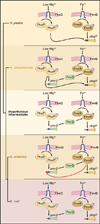Evolution of transcriptional regulatory circuits in bacteria
- PMID: 19632175
- PMCID: PMC2726713
- DOI: 10.1016/j.cell.2009.07.002
Evolution of transcriptional regulatory circuits in bacteria
Abstract
Related organisms typically respond to a given cue by altering the level or activity of orthologous transcription factors, which, paradoxically, often regulate expression of distinct gene sets. Although promoter rewiring of shared genes is primarily responsible for regulatory differences among related eukaryotic species, in bacteria, species-specific genes are often controlled by ancestral transcription factors, and regulatory circuit evolution has been further shaped by horizontal gene transfer. Modifications in transcription factors and in promoter structure also contribute to divergence in bacterial regulatory circuits.
Figures




References
-
- Alon U. Network motifs: theory and experimental approaches. Nat Rev Genet. 2007;8:450–461. - PubMed
-
- Balaji S, Aravind L. The two faces of short-range evolutionary dynamics of regulatory modes in bacterial transcriptional regulatory networks. Bioessays. 2007;29:625–629. - PubMed
-
- Beaber JW, Hochhut B, Waldor MK. SOS response promotes horizontal dissemination of antibiotic resistance genes. Nature. 2004;427:72–74. - PubMed
Publication types
MeSH terms
Substances
Grants and funding
LinkOut - more resources
Full Text Sources
Other Literature Sources

